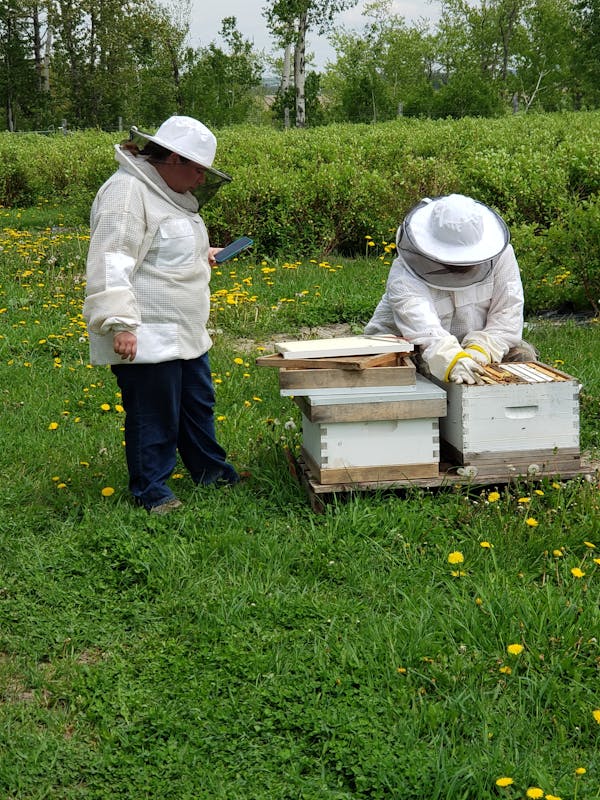Beekeeping is more than just a hobby; for many, it’s a passion and a way of life. However, working with bees comes with inherent risks. One of the most critical pieces of equipment for any beekeeper is the beekeeping jacket. This guide will explore the importance of a beekeeper’s jacket, its features, and how it ensures both protection and comfort while working with these fascinating insects.
The Importance of a Beekeeper’s Jacket
Beekeeping involves close interaction with bees, which can be unpredictable and defensive, especially if they feel threatened. Bee stings are not only painful but can also cause allergic reactions in some individuals. A well-designed beekeeper’s jacket serves as the first line of defense, reducing the risk of stings and providing a barrier between you and the bees. Comfort is paramount when spending long hours tending to your hives. A beekeeper’s jacket that fits well and is made from breathable material ensures that you remain comfortable, even during the hottest days. Comfort allows beekeepers to work more efficiently and enjoy their time with the bees. Knowing you are well-protected allows you to work confidently around your bees. This confidence can make a significant difference in how you handle the bees and perform necessary tasks. A sturdy and reliable jacket reduces anxiety and allows for smoother, more efficient work.
Key Features of a Beekeeper’s Jacket
The material of a beekeeper’s jacket is crucial for both protection and comfort. Most jackets are made from cotton, polyester, or a blend of both. Cotton is breathable and comfortable, making it an excellent choice for warmer climates. Polyester, on the other hand, is lightweight and provides additional durability. Many modern beekeeping jackets use a blend of cotton and polyester, combining the best features of both materials. These jackets offer breathability, comfort, and durability, making them suitable for various climates and conditions. The veil is one of the most critical components of a beekeeper’s jacket. It protects the face and neck from stings while allowing clear visibility and ventilation. There are several types of veils, each with its own advantages, such as fencing veils, round veils, and square veils. Ventilation is a crucial feature for beekeeping jackets, especially in warmer climates. Look for jackets with mesh panels or ventilation zippers that allow air to flow through, keeping you cool and comfortable during extended periods in the apiary. Functional pockets are essential for any beekeeping jacket. They provide convenient storage for tools, hive tools, and personal items like your phone or keys. Pockets with secure closures, such as zippers or Velcro, ensure that your belongings stay safe while you work. A good beekeeper’s jacket should have elastic bands or adjustable straps at the wrists and waist. These features help to secure the jacket and prevent bees from entering through gaps. Adjustable straps also ensure a snug fit, enhancing both protection and comfort.
Choosing and Maintaining Your Beekeeper’s Jacket
The climate in which you’ll be beekeeping plays a significant role in choosing the right jacket. In hotter climates, breathability and ventilation are paramount. Cotton or blended jackets with ample mesh panels are ideal. In cooler climates, a thicker, more insulated jacket might be necessary to keep you warm while working. A well-fitting jacket is essential for both protection and comfort. Jackets that are too loose can allow bees to enter, while those that are too tight can restrict movement and cause discomfort. Look for jackets with adjustable features to ensure a snug yet comfortable fit. Investing in a high-quality jacket is crucial for long-term use. Look for jackets made from durable materials with reinforced stitching. Quality zippers and closures are also important, as they will be used frequently and need to withstand wear and tear. While it’s important to invest in a quality jacket, there are options available for different budgets. Basic cotton jackets are often more affordable and provide adequate protection for beginners. As you gain experience and expand your apiary, you might consider investing in a higher-end jacket with additional features. Keeping your jacket clean is essential for maintaining its protective qualities and ensuring longevity. Most beekeeping jackets can be machine washed, but it’s important to follow the manufacturer’s instructions. Regular cleaning helps remove bee pheromones and other residues that could attract bees or degrade the material. Inspect your jacket regularly for signs of wear and tear. Small tears or loose stitching can be repaired with a needle and thread, but significant damage may require professional repair or replacement. Addressing damages promptly ensures your jacket remains effective and safe to use. When not in use, store your jacket in a cool, dry place away from direct sunlight. Avoid leaving it in damp or humid conditions, as this can lead to mold and mildew. Proper storage helps maintain the integrity of the material and prolongs the life of your jacket.
Additional Protective Gear and Tips for Safe Beekeeping
Gloves are an essential part of a beekeeper’s protective gear. They protect your hands from stings while allowing dexterity for handling bees and equipment. Gloves come in various materials, including leather, rubber, and nitrile. Choose a pair that offers a balance of protection and flexibility. Beekeeping pants or suits provide full-body protection. Like jackets, they are made from durable, breathable materials and often feature elastic bands at the ankles to prevent bees from entering. Some beekeepers prefer full suits for added security and convenience. Sturdy, closed-toe shoes or boots are recommended for beekeepers. They protect your feet from stings and provide stability when moving around the apiary. Some beekeepers also use gaiters to cover the gap between their pants and shoes, adding an extra layer of protection. Bees are sensitive to quick movements and can become agitated if they feel threatened. Stay calm and move slowly when working around your hives. This helps prevent stings and keeps the bees more relaxed. Bees are generally more docile during mid-morning and early afternoon when they are busy foraging. Avoid working with your hives during late evening or early morning, as bees are more likely to be defensive during these times. A smoker is an essential tool for beekeepers. The smoke masks alarm pheromones released by guard bees, helping to keep the colony calm. Use the smoker sparingly and direct the smoke gently towards the entrance and top of the hive. Beekeeping can be physically demanding, especially during hot weather. Make sure to stay hydrated by drinking plenty of water. Take breaks as needed to avoid overheating and fatigue. Plan your hive inspections in advance to minimize the time spent disturbing the bees. Have all your tools and equipment ready before you begin, and work methodically to complete tasks efficiently.
Conclusion
A beekeeper’s jacket is an indispensable piece of equipment that offers both protection and comfort. By choosing the right jacket, maintaining it properly, and combining it with other beekeeping accessories and protective gear, you can enjoy beekeeping safely and confidently. Remember, the key to successful beekeeping is not only about caring for the bees but also taking care of yourself. Invest in quality gear, stay informed, and always prioritize safety in your apiary adventures.



